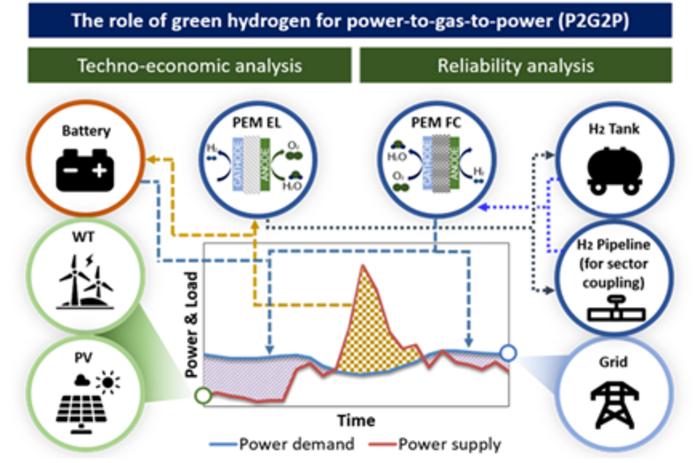A research team in Korea Institute of Energy Research has successfully demonstrated the effectiveness of a green hydrogen system used to supplement the volatility of renewable energy.
*Green hydrogen: Hydrogen obtained by electrolysis of water, in which electrical energy derived from renewable sources such as solar and wind power is applied to water to produce hydrogen and oxygen. This production method is an environmentally friendly hydrogen production process with no carbon dioxide emissions.

Credit: KOREA INSTITUTE OF ENERGY RESEARCH
A research team in Korea Institute of Energy Research has successfully demonstrated the effectiveness of a green hydrogen system used to supplement the volatility of renewable energy.
*Green hydrogen: Hydrogen obtained by electrolysis of water, in which electrical energy derived from renewable sources such as solar and wind power is applied to water to produce hydrogen and oxygen. This production method is an environmentally friendly hydrogen production process with no carbon dioxide emissions.
Dr. Joungho Park and his research team at the Energy AI and Computational Science Laboratory in the Korea Institute of Energy Research (KIER) have concluded that green hydrogen, which facilitates the conversion and storage of excess energy, is the most effective way to overcome the volatility of a renewable energy power grid that combines solar and wind power.
Renewable energy is increasingly emphasized as a key means to achieve carbon neutrality and energy security. At the 28th United Nations Conference of the Parties (COP-28, December 2023), an agreement was reached to triple renewable energy generation capacity by 2030. In support of this global initiative, the Republic of Korea also announced the “Strategy for Expanding the Distribution and Strengthening the Supply Chain of Renewable Energy” (Ministry of Trade, Industry and Energy, May 2024) to support the sustainable growth of the domestic renewable energy industry.
To expand renewable energy, it is critical to manage the variability of factors such as intermittent solar radiation and wind speeds, in addition to distribution. Ensuring the safety and efficiency of power operations requires the ability to respond flexibly to both shortages and surpluses. As a solution, Power-to-Gas (P2G) technology is proposed, which uses surplus renewable energy to produce carbon-free green hydrogen and compensates for variability through timely use.
*P2G (Power-to-Gas): A technology that converts electricity into a gas, such as hydrogen or methane, using renewable electrical energy from sources such as solar and wind power, and allows it to be stored.
The research team developed a model to determine the optimal scale and verify the effectiveness of a green hydrogen system needed for a renewable energy power grid. The model is based on the weather data and electricity demand data of Jeju Island, where solar and wind power generation account for 20% of the total power generation. This allows the model to derive the optimal scale of the green hydrogen system in line with the 2030 target of achieving a 21.6% share of renewable energy generation.
When meteorological data such as wind speed, solar radiation and temperature are entered into the developed model, hourly power production is calculated and compared with actual power demand data. By doing this, we check the adequacy of power supply and demand, and in case of over- or under-supply, we apply a green hydrogen system and batteries to determine the optimal system Levelized Cost of Electricity (sLCOE) and Loss Probability of Power Supply (LPSP). Thus, the economic feasibility and stability of each green hydrogen and battery system can be determined as a function of scale, and the optimal scale can be predicted.
*sLCOE (System Levelized Cost of Electricity): This term refers to the levelized cost of electricity, which is calculated by dividing the total capital and operating costs for power generation by the total amount of delivered electricity. Unlike the traditional LCOE, which is based on the total amount of produced electricity and does not account for power loss costs such as output restrictions, sLCOE addresses these shortcomings by considering the delivered electricity.
**LPSP (Loss of Power Supply Probability): This is an indicator of power grid stability, calculated by dividing the delivered electricity by the required electricity. A value close to 0 indicates that the power supply is adequately meeting the demand. If the value is greater than 0, it implies that the demand is not being fully met, which can lead to power outages. Therefore, an energy conversion and storage system is needed to make up for this shortfall.
The simulation results using the model showed that when solar power is used alone, batteries are the most effective solution for overcoming variability, whereas when wind power is used alone, green hydrogen is the most effective. However, when solar and wind power are combined equally, green hydrogen demonstrated the highest economic efficiency and the lowest power supply losses. This finding aligns with policy directions promoting a balanced deployment of both solar and wind power, and can serve as foundational data for establishing renewable energy transition strategies.
Dr. Joungho Park, the first author, stated, “This study is significant as it verifies the effectiveness of using green hydrogen to address power grid instability and output restriction issues arising from the expansion of renewable energy.” He added, “By designing optimal energy conversion and storage system setups tailored to the characteristics and situations of different regions, this research provides insights for the government and companies to develop green hydrogen-related strategies, thus facilitating rational decision-making.”
This research, conducted in collaboration with Professor Jay H. Lee’s team from the Mork Family Department of Chemical Engineering and Materials Science at the University of Southern California (USC), has been published in the international journal ‘Energy Conversion and Management.’ The study was supported by the basic research program of the Korea Institute of Energy Research (KIER).
Journal
Energy Conversion and Management
Article Title
Enhancing the economic viability and reliability of renewables based electricity supply through Power-to-Gas-to-Power with green hydrogen
Article Publication Date
3-May-2024



